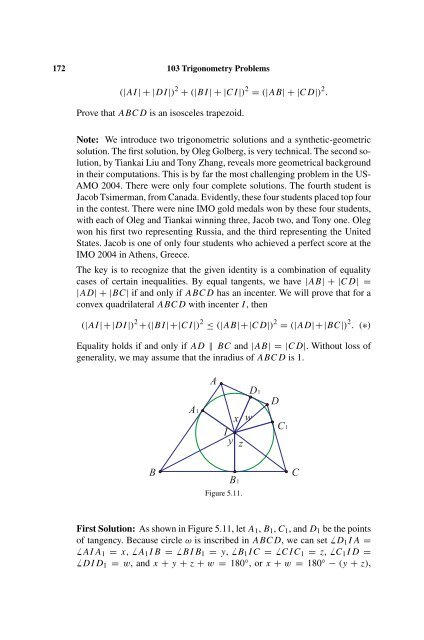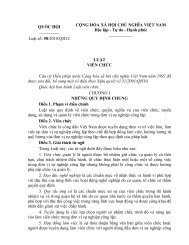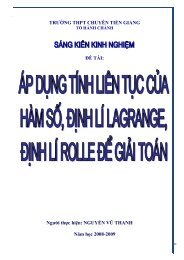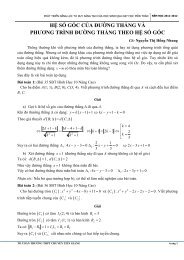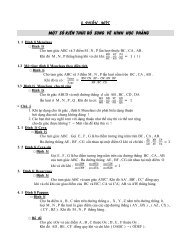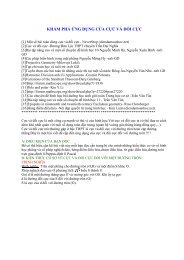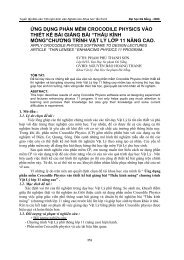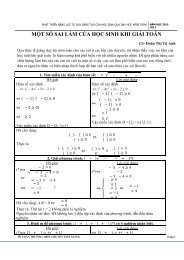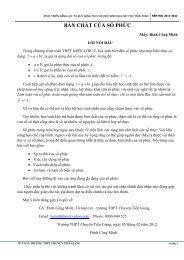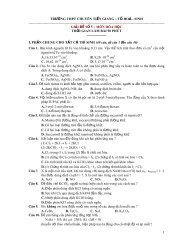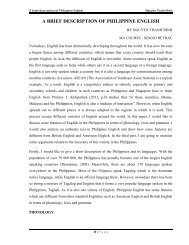103 Trigonometry Problems
103 Trigonometry Problems
103 Trigonometry Problems
Create successful ePaper yourself
Turn your PDF publications into a flip-book with our unique Google optimized e-Paper software.
̸<br />
172 <strong>103</strong> <strong>Trigonometry</strong> <strong>Problems</strong><br />
(|AI|+|DI|) 2 + (|BI|+|CI|) 2 = (|AB|+|CD|) 2 .<br />
Prove that ABCD is an isosceles trapezoid.<br />
Note: We introduce two trigonometric solutions and a synthetic-geometric<br />
solution. The first solution, by Oleg Golberg, is very technical. The second solution,<br />
by Tiankai Liu and Tony Zhang, reveals more geometrical background<br />
in their computations. This is by far the most challenging problem in the US-<br />
AMO 2004. There were only four complete solutions. The fourth student is<br />
Jacob Tsimerman, from Canada. Evidently, these four students placed top four<br />
in the contest. There were nine IMO gold medals won by these four students,<br />
with each of Oleg and Tiankai winning three, Jacob two, and Tony one. Oleg<br />
won his first two representing Russia, and the third representing the United<br />
States. Jacob is one of only four students who achieved a perfect score at the<br />
IMO 2004 in Athens, Greece.<br />
The key is to recognize that the given identity is a combination of equality<br />
cases of certain inequalities. By equal tangents, we have |AB| +|CD| =<br />
|AD|+|BC| if and only if ABCD has an incenter. We will prove that for a<br />
convex quadrilateral ABCD with incenter I, then<br />
(|AI|+|DI|) 2 +(|BI|+|CI|) 2 ≤ (|AB|+|CD|) 2 = (|AD|+|BC|) 2 .(∗)<br />
Equality holds if and only if AD ‖ BC and |AB| =|CD|. Without loss of<br />
generality, we may assume that the inradius of ABCD is 1.<br />
A1<br />
A<br />
x w<br />
I<br />
y z<br />
D1<br />
D<br />
C1<br />
B<br />
B1<br />
Figure 5.11.<br />
C<br />
First Solution: As shown in Figure 5.11, let A 1 , B 1 , C 1 , and D 1 be the points<br />
of tangency. Because circle ω is inscribed in ABCD, we can set ̸ D 1 IA =<br />
̸ AIA 1 = x, ̸ A 1 IB = ̸ BIB 1 = y, ̸ B 1 IC = ̸ CIC 1 = z, ̸ C 1 ID =<br />
DID 1 = w, and x + y + z + w = 180 ◦ ,orx + w = 180 ◦ − (y + z),


